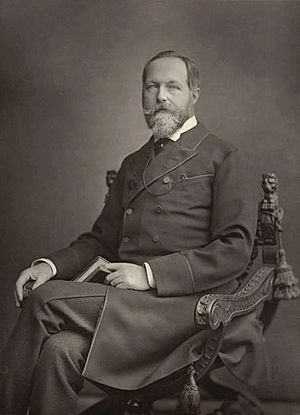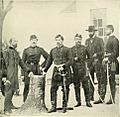Prince Philippe, Count of Paris facts for kids
Quick facts for kids Philippe |
|||||
|---|---|---|---|---|---|
| Count of Paris | |||||
 |
|||||
| King of the French (disputed) as Louis-Philippe II |
|||||
| Reign | 24 February 1848 – 26 February 1848 (Unproclaimed) |
||||
| Predecessor | Louis Philippe I | ||||
| Successor | Monarchy abolished Jacques Dupont de l'Eure as Head of the Provisional Government |
||||
| Orléanist-Unionist pretender to the French throne as Philippe VII |
|||||
| Pretence | 24 August 1883 – 8 September 1894 | ||||
| Predecessor | Henri, Count of Chambord | ||||
| Successor | Philippe, Duke of Orléans | ||||
| Orléanist pretender to the French throne as Louis-Philippe II |
|||||
| Reign | 24 February 1848 – 5 August 1873 | ||||
| Predecessor | Louis Philippe I | ||||
| Successor | Claim ended | ||||
| Born | 24 August 1838 Tuileries Palace |
||||
| Died | 8 September 1894 (aged 56) Stowe House, England |
||||
| Burial | Chapel of St. Charles Borromeo, Weybridge (1894–1958) Royal Chapel of Dreux (since 1958) |
||||
| Spouse |
Princess Marie Isabelle d'Orléans
(m. 1864) |
||||
| Issue | Amélie, Queen of Portugal Philippe, Duke of Orléans Princess Hélène, Duchess of Aosta Prince Charles Isabelle, Duchess of Guise Prince Jacques Louise, Princess Louise of Bourbon-Two Sicilies Prince Ferdinand, Duke of Montpensier |
||||
|
|||||
| House | Orléans | ||||
| Father | Prince Ferdinand, Duke of Orléans | ||||
| Mother | Duchess Helene of Mecklenburg-Schwerin | ||||
| Religion | Roman Catholicism | ||||
| Signature | |||||
Prince Philippe of Orléans, Count of Paris (born Louis Philippe Albert; August 24, 1838 – September 8, 1894) was a French prince. Some people believed he should have been the King of the French for a short time in 1848. He was the grandson of Louis Philippe I, who was the King of the French. From 1848 until his death, he was known as the Count of Paris and was seen by some as the rightful claimant to the French throne.
Contents
Early Life and Adventures
Philippe became the Prince Royal, which meant he was the next in line to the throne, when his father, Prince Ferdinand-Philippe, died in a carriage accident in 1842. In 1848, his grandfather, King Louis Philippe I, gave up the throne. There was an attempt to make young Philippe king, with his mother (Helene of Mecklenburg-Schwerin) ruling for him as a Regent (someone who governs for a young or absent ruler). However, this plan did not work out. Philippe and his family had to flee France, and the French Second Republic was created.
Later, Philippe became a historian and journalist. He was also a strong supporter of democracy. He volunteered to serve as an officer in the Union Army during the American Civil War. His younger brother, Prince Robert, joined him. Philippe was made an assistant general on September 24, 1861, and served under the name Philippe d'Orléans, the Count of Paris. He worked for General George McClellan, who led the Army of the Potomac. Philippe showed great bravery during the Peninsular Campaign, even though it was not successful. He and his brother left the Union Army on July 15, 1862. Philippe later wrote an important book about the Civil War.
During their time in the United States, the princes were with their uncle, the Prince of Joinville. Their uncle painted many pictures of their journey. In 1880, Philippe was honored by the Military Order of the Loyal Legion of the United States, an organization for Union officers from the Civil War. His oldest son, Philippe d'Orleans, also became a member of this group later.
Marriage and Family
On May 30, 1864, in Kingston upon Thames, England, Philippe married his cousin, Princess Marie Isabelle d'Orléans (1848–1919). She was a Spanish princess. They had eight children together:
- Princess Amélie d'Orléans (1865–1951); she married Carlos I of Portugal in 1886.
- Prince Louis Philippe Robert d'Orléans, Duke of Orléans (1869–1926); he married Archduchess Maria Dorothea of Austria in 1896.
- Princess Hélène of Orléans (1871–1951); she married Emmanuel Philibert, 2nd Duke of Aosta in 1895.
- Prince Charles d'Orléans (1875–1875).
- Princess Isabelle d'Orléans (1878–1961); she married Prince Jean D'Orléans, Duke of Guise in 1899.
- Prince Jacques d'Orléans (1880–1881).
- Princess Louise d'Orléans (1882–1958); she married Prince Carlos of Bourbon-Two Sicilies in 1907. Her granddaughter, Maria Mercedes, was the mother of King Juan Carlos I of Spain.
- Prince Ferdinand d'Orléans, Duke of Montpensier (1884–1924); he married Marie Isabelle Gonzales de Olañeta y Ibaretta in 1921.
Attempts to Restore the French Monarchy
The Orléans family had been living in England since the French Revolution of 1848. This revolution had removed King Louis Philippe from power. When Philippe and his wife first married, they lived in York House, England.
In 1871, after the Franco-Prussian War and the end of Napoléon III's rule, the family was allowed to return to France. Many of their family properties were given back to them. In 1873, there was a chance that France might become a monarchy again. The Count of Paris decided to step aside and support another person who claimed the throne, Henri V. Henri was from a different branch of the royal family, called the Legitimists. Most people thought that the Count of Paris would become king after Henri, as Henri had no children. This would have brought the two royal family lines back together.
However, Henri V refused to accept the French flag (the tricolor). This made it impossible for him to become king. Henri died in 1883 without naming the Count of Paris as his heir.
After Henri's death, most people who wanted a king in France recognized the Count of Paris as Philippe VII of France. However, some other royal family members from Spain, called the Carlists, disagreed. They believed they had a stronger claim because they were directly descended from an older French king, Louis XIV. But this argument ignored an old agreement, the Treaty of Utrecht, where the Spanish king had given up his claim to the French throne.
In 1886, Philippe and his family were sent away from France again. They returned to England, living first at Sheen House and then at the larger Stowe House. Philippe died there in 1894. His son, Prince Philippe, then became the next person to claim the French throne.
Honours
 Saxe-Weimar-Eisenach: Grand Cross of the Order of the White Falcon, August 24, 1856
Saxe-Weimar-Eisenach: Grand Cross of the Order of the White Falcon, August 24, 1856 Denmark: Knight of the Order of the Elephant, October 22, 1885
Denmark: Knight of the Order of the Elephant, October 22, 1885 Kingdom of Portugal: Grand Cross of the Sash of the Two Orders, May 22, 1886
Kingdom of Portugal: Grand Cross of the Sash of the Two Orders, May 22, 1886
Images for kids
-
Philippe d'Orléans (first from right) with staff and important people of General McClellan (center). To his right is his uncle François d'Orléans.
See also
 In Spanish: Felipe de Orleans (1838-1894) para niños
In Spanish: Felipe de Orleans (1838-1894) para niños


